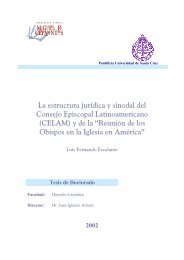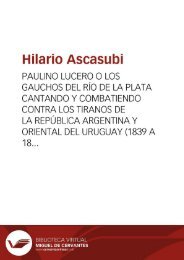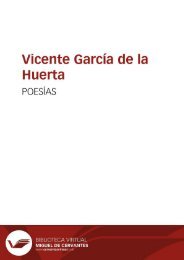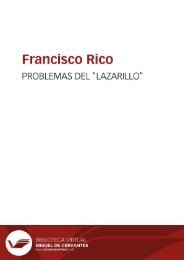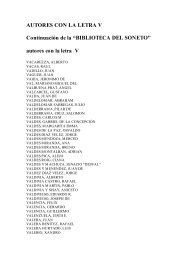You also want an ePaper? Increase the reach of your titles
YUMPU automatically turns print PDFs into web optimized ePapers that Google loves.
Anales galdosianos [Publicaciones periódicas]. Año XII, 1977<br />
composición del caballero, como un precioso afeite aplicado a embellecer la personalidad »; and the<br />
name, it turns out, suits him so well « que el sujeto no se podía llamar de otra manera » (V, 1541).<br />
Nazarín, thanks to its peculiar structure, is a statement on the act of writing. And in Misericordia , the<br />
whole puzzling episode of Don Romualdo can be explained only, but quite easily, as a manifestation<br />
of fiction's miraculous powers of creation.<br />
All these instances reflect the concern on <strong>Galdós</strong>' part with the problem that Erich Kahler in his<br />
interesting little book, The Disintegration of Form in the Arts (New York: Braziller, 1968), considers<br />
a mark of our times. He says: «more recently the problem of how to render the bewildering complexity<br />
of out reality has become the very subject matter of certain works of art. [This] means the presentation<br />
in a work of art of the artist's struggle with his task -a kind of artistic epistemology» (p. 6). The<br />
French «new» novelist Alain Robbe-Grillet, avowed enemy of art that signifies anything external to<br />
art, expresses the same thought: «What constitutes the novelist's strength is precisely that he invents,<br />
that he invents quite freely, without a model. The remarkable thing about modern fiction is that it<br />
asserts this characteristic quite deliberately, to such a degree that invention and imagination become,<br />
at the limit, the very subject of the book» 131 . El amigo Manso is at the least a venerable example<br />
of what Wellek and Warren call the «romantic-ironic» mode of narration 132 . More than that, it is<br />
<strong>Galdós</strong>' most expansive statement on the problematic nature of fiction.<br />
Chapter I, with Chapter L at its heels, is the structure that shapes the entire novel. In fact, the two<br />
chapters are the unit that comprises the novel in question here: the story of fiction. Between them,<br />
they contain a fictional story. The outer novel serves to distance the interior novel from itself and<br />
from the reader, along lines that turn out to be as Brechtian as they are Cervantine. The interior novel,<br />
if framed, must occupy a space inside and lesser than the framed whole (that is, Chapters I through L<br />
span more pages than Chapters II through XLIX). At the same time, the interior novel is perceived by<br />
the reader as a contained image. But in its function, the frame of a novel is quite unlike a picture frame,<br />
which one might rather compare to the covers of a book. The physical frame of a picture is normally<br />
an adventitious, externally imposed element, which the modern painter regularly prefers to suppress,<br />
leaving the picture to be bound by its natural limits. The novel's frame is an intrinsic member of the<br />
imaginative construct and does not outline decoratively the image it contains nor simply circumscribe<br />
131 For a New Novel (New York: Grove Press, 1965), p. 32.<br />
132 René Wellek and Austin Warren, Theory of Literature , 3rd ed. (New York: Harcourt, Brace,<br />
1956), p. 223.<br />
94








